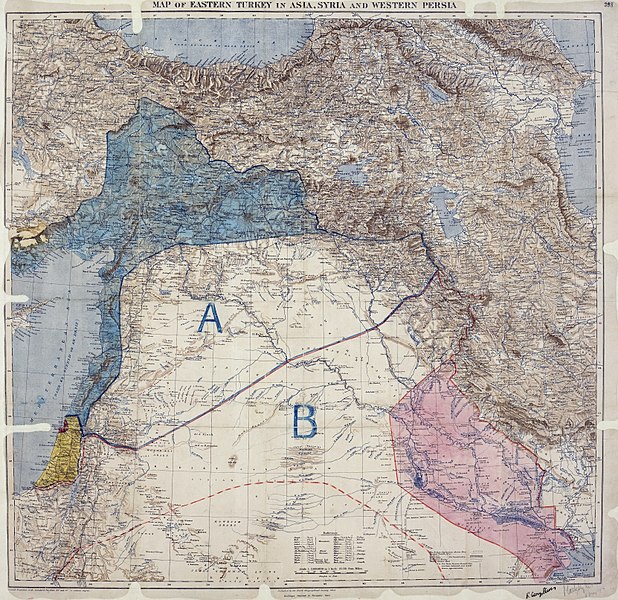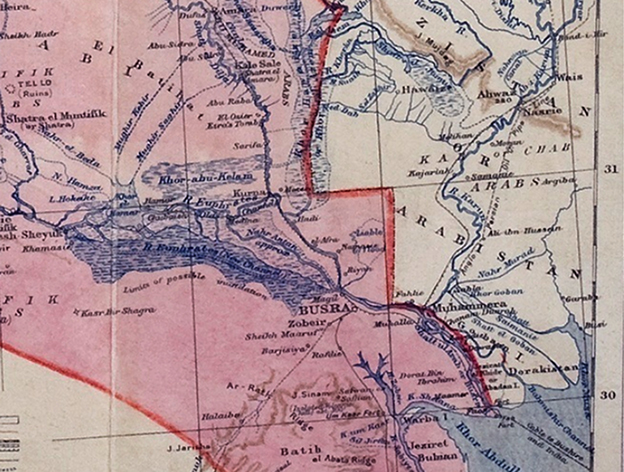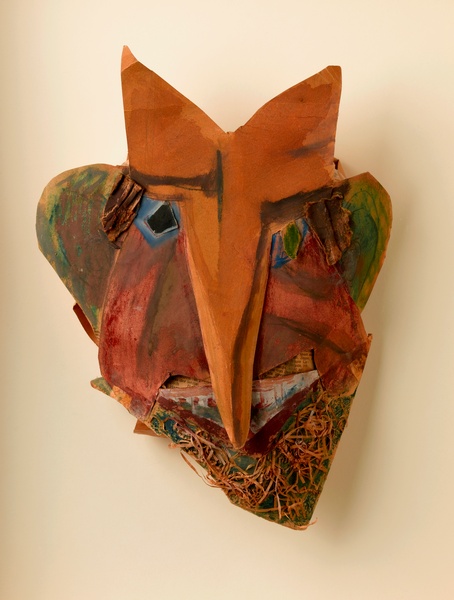A Line to the Last “K” in Kirkuk
by Pil and Galia Kollectiv
In Moscow, 1916, Lyubov Popova unveiled her series of six new paintings entitled “Painterly Architectonics”, demonstrating a stylistic shift to suprematist abstraction. Although sharing the colourful and diagonal arrangement of Malevich’s suprematist compositions, Popova’s shapes were heavier and less invested in speed and movement. More centralized on the canvas, they were also denser and allowed for hardly any negative ‘dead’ spaces to peek out from between blocks of colour. But what was most striking about Popova’s paintings was the fact that despite engaging with architectural space, these compositions were distinctly not three dimensional and the only ‘depth’ came from the fact that the solid blocks of colour seemed to be stacked one on top of the other. If we accept the invitation to think of these in terms of architecture, then rather than take the point of view of the street dweller looking up at a multi-story building from below, these architectural shapes look like the flattened out contours of target buildings during an aerial bombardment.

Lyubov Popova, Painterly Architectonics, 1916
In the same year, another surface was painted over with blue, red and yellow to create five blobby shapes, awkwardly balanced against each other and not dissimilar to Popova’s. The composition here is also bold: diagonal lines violently lash out of the solid centers to form narrower strips, the lines crease and fragment along the edges and a smaller golden triangle with a red dot sits at the bottom of two much larger shapes, like a toe sticking out of the image. The painted surface in question is a map, published by the Royal Geographic Society in 1910, of Eastern Turkey in Asia, Syria and Western Persia. The ‘artists’ who drew the lines and arranged the composition on the map were Mark Sykes and François Georges-Picot, tasked with the partitioning of the Othoman Empire between Britain, France and Russia in the event of its imminent collapse during the first world war.

Malevich thought that by turning away from mimetic representation, the suprematist painting allowed the surface to be born into the world as a living thing, detached from what it is meant to represent: “a painted surface is a real, living form”, he wrote in his 1915 manifesto “From Cubism and Futurism to Suprematism: The New Realism in Painting”. Without realising it, Sykes and Picot followed this logic perfectly. Trampling the representational aspirations of the map under the harsh geometry of their lines, they too gave birth to a new entity, the Middle East, dragged into this world kicking and screaming for a hundred years of violence. A map stands for ‘real’ objects – mountains, villages, rivers, but Sykes and Picot’s stands for nothing but an expression of the abstract logic of geopolitical power. In one corner, near a title that reads ‘Arabistan’, just north of Basra in Iraq, the line that they drew simply follows the map’s grid, as if the diplomats got tired of haggling at some point. Dividing modern day Iraq and Iran into neat little cubes, the border here resembles somewhat the Bauhaus logo of a face drawn in an ultra-cubist style. Sykes is quoted as saying: "I should like to draw a line from the “e” in Acre to the last “k” in Kirkuk". [1] The space he was splicing was clearly a virtual one for him, spanning expanses defined be the distances between printed letters on a piece of paper. Plenty of maps were shaped in the age of colonialism where national units are carved out crudely with little regard to existing conditions, but here the anonymous cartographer from the Royal Geographic Society had a real hand at shaping places and destinies: some of the bloodiest battles of the Iran-Iraq war in the 1980s took place along these lines. It is not hard to see why in 2014 Isis released a video entitled “The End Of Sykes-Picot” in which a bulldozer is seen destroying a section of the border between Syria and Iraq.

The grid of Modernist painting, writes Rosalind Krauss, resisted the semiotic relationship between a real world and the painted image – it was an unchangeable surface under which the ‘world’ could move endlessly without altering its qualities:
Perspective was the demonstration of the way reality and its representation could be mapped onto one another, the way the painted image and its real-world referent did in fact relate to one another - the first being a form of knowledge about the second. Everything about the grid opposes that relationship, cuts it off from the very beginning. Unlike perspective, the grid does not map the space of a room or a landscape or a group of figures onto the surface of a painting. Indeed, if it maps anything, it maps the surface of the painting itself. It is a transfer in which nothing changes place. [2]
In other words, the grid is what she calls ‘materialist’ – an element of the painting that never lets the viewer forget that geometric illusionist space is untrustworthy. But at the same time, Krauss notices that the grid is also transcendental: it implies that space can go on forever and that what the viewer encounters within the frame of the painting is potentially only a small segment of the space that is inevitably not shown.
So how can we read a national territory that was drawn from a map grid? To start with, Sykes-Picot’s Iraqi border goes beyond even the Baudrillardian ‘hyper-real’, where the map precedes and determines any notion of a ‘real’ world. Here it is not the map (bearing some representational correlation with a real world) that is originary, but rather we are presented with a technology of rationalising space in representational form that precedes any specific map. More than this, following Krauss line of argumentation, we face a paradoxical tension between the materialist and the transcendental. On the one hand, this grid based border is a reminder that the illusion of nationalism, of homeland and patriotism, stands for nothing and that the fact that space is sliced off to little parcels of national land has no grounding in anything ‘natural’ or real. On the other hand, it also reflects the infinite logic of capitalism where space is an abstraction removed from any real and considered as a vector of flows between liquid locations. It is important to remember that, at its heart, the proposed agreement over spheres of influence in the middle east was about free flows of goods – ports, oil fields, naval bases and railways are of vital importance here. So despite imposing national borders on a previously fluid space, the agreement is really interested in accelerating the movement of materials, goods and capital across the territory. The domain of capital does not recognise the solid albeit fictitious form of the nation-state and imposes upon it the abstract language of financialisation, a regime of graphs and pie charts where the grid is king. In this sense, the Sykes-Picot map deterritorializes with one hand what it reterritorializes with the other.
One of the main projects undertaken by the national assembly in the aftermath of the French revolution was the re-division and re-drawing of the inflated municipal map of the Ancien Regime. The old map had been shaped by a slow process of accumulation of traditions, political alliances, ethnic and cultural differences as well as by the actual physical terrain. The new and much more efficient map allowed for greater centralisation of control and cohesion, for more profitable tax collection and for a significant reduction in the number of officials and clergymen ‘on the books’. But perhaps the most obvious aspiration of this remapping exercise was the relocating of the basic unit of subjective identification for the citizen. For example, one was not to identify oneself anymore as Catalonian residing in what had been in the past part of the principally of Catalonia, even if in your town everyone still spoke Catalonian. Instead, one was now first and foremost a French citizen who happened to live in the municipal department of the Eastern Pyrenees. The new unit of identification, the republican nation state, was also a measure of ownership. It did not belong to a Bourbon king, certainly not to God, but to all its citizens – they were French because they owned France.
If one follows the logic of Friedrich Engels and Rosa Luxemburg, it is exactly the notion of private ownership that stands at the heart of the division of colonial occupied land into distinct national entities. The modern abstract unit of the nation state is simply a method of transforming a heterogeneous group of people, resources, customs, languages and landscapes into a ecosphere of indebted consumers, free flowing commodities and raw materials, accumulated wealth and surplus labour. Within the colonial nation state, access to what was before free and universal – grazing areas for cattle, fresh water, fishing areas etc. – becomes restricted. Now that resources are divided along national and municipal borders and subject to state regulation, taxation and customs control, workers are forced to sell their labour in order to buy back what is effectively theirs. In this respect the Sykes-Picot map is an elaborate blueprint for robbery. Only here, the victims are made to carry the stolen goods for the robbers and be grateful.
In 1916, another art movement exploded onto the world stage. In Zurich, a group of mostly young artists escaping the war created a truly pan-European movement to celebrate a new brand of universalism under the banner of Dada. Tristan Tzara wrote later, approvingly, on the American embrace of Dada:
Dada belongs to everybody. Like the idea of God or of the toothbrush. There are people who are very dada, more dada; there are dadas everywhere all over and in every individual. Like God and the toothbrush. [3]
For the first time in modern history an art movement made the curatorial convention of dividing exhibition space into rooms devoted to national schools look ridiculous. However, paradoxically, it was precisely the local specificity of their aesthetic, often neglected in art historical accounts, that gave birth to this transnational style. In their use of carnivalesque masks, costumes and forms of acting and singing derived from a preference for theatre as an oral, improvisational act, the Romanian Jewish immigrants who formed the core of the group (Tristan Tzara, Marcel Janco, Artur Segal) transposed an established Eastern folk tradition onto a Western European art. [4] In spite of Dada’s staunch rejection of religion, particularism and nationalism, they adopted forms like the religious village fete.


Traditional Romanian Masks; Marcel Janco, Mask, 1919
It would be easy to read Dada as participating in the same kind of exoticising of the ‘primitive’ that so many twentieth century art movements reveled in. But these artists’ use of folk art ultimately sought to undo the categories of high and low art, not in the name of an authentic local identity, but for the sake of creating a new language in the recognition that the new could only ever be borne of the debris left behind by the old world. This project is perhaps best encapsulated in Henri Lefebvre’s claim that “Dada smashes the world, but the pieces are fine”. [5] It is this willingness to construct a world from the pieces rather than imagine one as pure geometric abstraction that differentiates this strand of modernism from that of Sykes and Picot. If we are to retain any hope for a universal subject, it is not in the guise of the global subject of neo-liberal fantasy, reinventing the self ever more quickly to compete with the automation that is fast catching up with the last vestiges of extractable human capital. The new universal subject will of necessity be an immigrant, carrying the dregs of the old world of local identities across borders that already crumble in the face of financial flows and ecological catastrophe.
[1] Barr, James, A Line in the Sand: Britain, France and the Struggle that Shaped the Middle East, London: Simon and Schuster, 2011, p. 12.
[2] Krauss, Rosalind, "Grids", in: October, Cambridge, MA: MIT, Vol. 9 (Summer, 1979), p. 52.
[4] Sandqvist, Tom, Dada East: The Romanians of Cabaret Voltaire, pp. 247-8